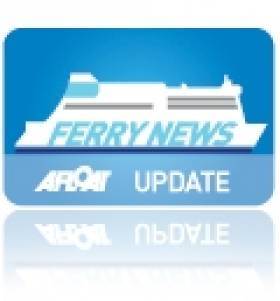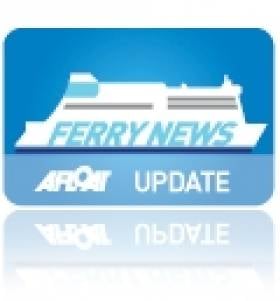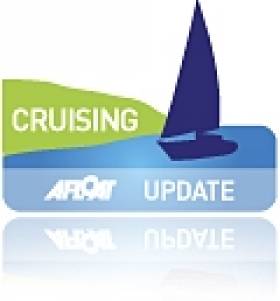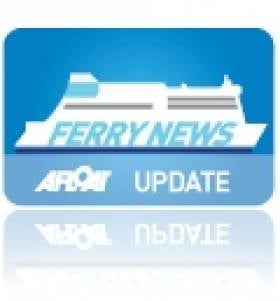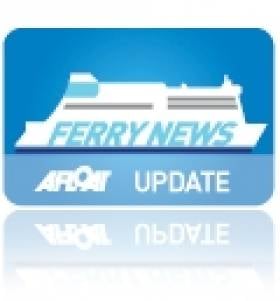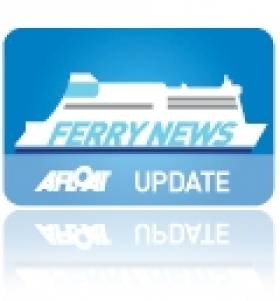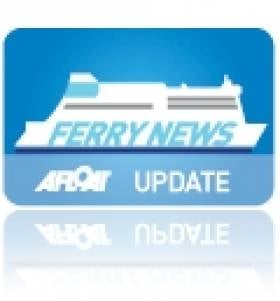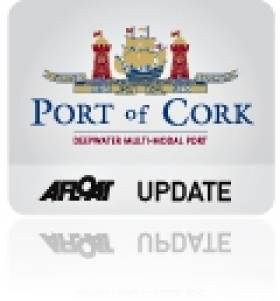Displaying items by tag: Brittany Ferries
Disruption Continues on Brittany Ferries Services
#FERRY NEWS - Industrial action by French crews with Brittany Ferries is still disrupting the company's ferry services from Cork to Roscoff.
As previously reported on Afloat.ie, a series of wildcat strikes by staff protesting against changes to their working terms and conditions began last Friday 21 September.
The action led to the cancellation of sailings on the weekend-only round-trip Cork route until further notice.
Passengers intending to travel from Cork have been advised to seek passage instead on Celtic Ferries' Rosslare-to-Cherbourg route or Irish Ferries' Rosslare services to Cherbourg.
Ports & Shipping Review: Stena HSS Comes and Goes, Shackleton Exhibition, Cork Harbour Open Weekend,Cargoship Dispute and Ferry Strike
#PORTS & SHIPPING REVIEW - Over the last fortnight Jehan Ashmore has reported from the Shipping scene where the Stena Line HSS seasonal-only operated Dun Laoghaire-Holyhead service completed its final sailing for the summer, though sailings are to resume over Christmas/New Year period.
Despite the HSS Stena Explorer's last high-season sailing on 11 September, the fast-ferry made a return call to Dun Laoghaire five days later, for a special freight-only charter, to load stage trucks following the Lady Gaga concert held in the Aviva Stadium, Dublin.
Incidentally the ferry terminal in Dun Laoghaire now features a new exhibition space, where the Tanaiste Eamonn Gilmore, T.D. officially launched the Shackleton Endurance Exhibition – 'Triumph Against All Odds'.
The Cork Harbour Open Weekend provided a great opportunity for locals and visitors alike to see what the world's second largest natural harbour has to offer, in terms of activities held on and off the water, including trips to Spike Island.
At Cobh a detained French registered fishing vessel was escorted to the town by the Naval Service OPV L.E. Roisin, following alleged breaches of technical fishing regulations.
A Dutch owned cargoship, the Julia, which docked in Drogheda Port faced arrest, following claims by its crew that they were owed in total $102,700 in unpaid wages to them.
The summer may be over, but that's not stopping Irish Ferries offering Autumn short shopping breaks and wine mini-cruises on the route to Cherbourg.
While rivals Celtic Link Ferries, found themselves taking additional business at short notice, as passengers were transferred from the cancelled Brittany Ferries Roscoff-Cork sailing, following strike-action by French staff over a dispute on new working conditions.
Celtic Link Ferries will however be expecting a response from customers as they take part in Gathering 2013, as the ferry operator are offering free car travel on 15th March next year in advance of St. Patricks Day celebrations.
Leo Varadkar, Minister for Transport, has appointed James Frater to the board of the Dublin Port Company. The Scot has held senior positions at ports in the UK, Egypt, Hong Kong and Oman.
Strike Action Leads to Cancelled Brittany Ferries Sailings
#SAILINGS CANCELLED – Due to a series of wildcat strikes yesterday by French employees of Brittany Ferries, the company has cancelled sailings on the Cork-Roscoff route until further notice and on its other routes to the UK and Spain.
The cancellation of sailings on the weekend only (round-trip) operated Irish route, led to passengers having to take alternative travel arrangements. Instead of departing Roscoff last night, passengers were given passage on board last night's departure from Cherbourg using the Celtic Link Ferries service to Rosslare, which is scheduled to arrive later today at lunchtime.
It has been suggested by Brittany Ferries, that customers who had booked on today's (cancelled) 16.00hrs sailing from Cork to Roscoff, should instead depart Rosslare with Celtic Link Ferries or Irish Ferries which also operates to Cherbourg.
For information and sailing updates from Brittany Ferries click HERE.
New Marina at French Ferryport Opens Up Strategic Cruising Potential
#NEW MARINA – Roscoff ferryport built four decades ago and initially used to export produce of a Breton farmer's co-operative to UK markets, through B.A.I then a fledging ferry concern, otherwise known today as Brittany Ferries, is now accompanied by a new 625-berth marina, writes Jehan Ashmore.
The marina at the Port de plaisance Roscoff-Bloscon, is a development of the Chambre de Commerce etd 'Industrie de Morlaix (CCI) and has been operational since June, however the marina's service buildings will not be completed until summer 2013.
Roscoff's position on the French north-west coastline promises to be a major draw to sailors wishing to stop off for a few days on cruising grounds along the French coast, Channel Islands or en-route to somewhere more distant. The port is also an ideal place for sailors as there are numerous islands as well as hidden coves and pretty harbours to discover.
Another advantage is the ferryport's links not just to Plymouth but also to Irish ports, with Irish Ferries running from Rosslare(May-September) and Brittany Ferries as previously reported on Afloat.ie which operates on a longer seasonal service from Cork, from March to November, with this year's final sailing on Saturday 3rd.
Boat-owners across the English Channel will be tempted to moor at the marina on a morepermanent basis,as it is claimed that berthing fees compare very favourably with those available in the UK. For further details of the new marina visit: www.morlaix.cci.fr
Ferries Great and Small during Cork Harbour Open Weekend
#FERRY NEWS – Coinciding with Cork Harbour Open Weekend, will be the regular departure today of Brittany Ferries 'flagship' Pont-Aven (2004/41,748grt). The cruiseferry which features an indoor swimming pool, is scheduled to depart later this afternoon, writes Jehan Ashmore.
The cruiseferry operates on the shortest Irish-French route, taking 14 hours to reach the Breton port of Roscoff. The ferry only calls to Cork (Ringaskiddy) on Saturday's, on the seasonal-service which is to cease sailings in November. Currently the company has a single fare from €70 per person based on a car plus four passengers including a 4-berth inside cabin, for information click HERE.
While on a domestic front, services running within the waters of the natural harbour, are provided by Cork Harbour Cruises, where the tender Spirit of the Isles runs between Cork City centre downriver to Cobh. In September, sailings depart Cork at 11am (Saturdays and Sundays). The operator also provides tours beyond Cobh and a Spike Island tour. For details visit: www.corkharbourcruises.ie/tours.php
During the Cork Harbour Open Weekend, there will be free ferry (RIB based) shuttle services run by Whale of A Time, which will serve on a circuit throughout the lower harbour (on both days 12noon-3pm), for further details click HERE.
Seasonal Start for Three In A Row
#FERRY NEWS – By this weekend three seasonal-only operated routes from the island of Ireland will have resumed service since the recent change of the clocks marking the start of summertime, writes Jehan Ashmore.
Sailings started today on Stena Line's Dun Laoghaire-Holyhead (120 minutes) fast-craft HSS Stena Explorer operated service. The central corridor route closed last September due to cost-saving measures as previously reported. For further details on sailing schedule click HERE.
The reopening of the Welsh route follows yesterday's launch of P&O Ferries fast-craft sailings to Scotland between Larne-Troon (2 hours) served by the 92m Express. She also runs additional sailings on the year-round Larne-Cairnryan route served by a pair of conventional ferry sisters. To read more information on both sailing route schedules click HERE.
The remaining route to re-open is Brittany Ferries Cork-Roscoff (14 hours) service operated by the 2,400 passenger 'flagship' Pont-Aven, which features an indoor swimming pool. Her first sailing for this year is tonight's sailing from the Breton port.
The corresponding Irish sailing departs tomorrow afternoon and the inaugural round trip is due to be completed with an arrival in France on Sunday morning. For sailing times click HERE.
National Ferry Fortnight Launched
#FERRY FORTNIGHT – With today's St. Patrick's Day festivities, the national event also coincides with the launch of our nearest neighbour's National Ferry Fortnight (17th-30th March) campaign held in the UK, writes Jehan Ashmore.
Each year around 13m people travelled between the UK and Ireland while more than 10m people took to the skies.
The UK has an extensive ferry network of approximately 50 routes including those serving the islands. Of the 11 shipping operators that are members of the Passenger Shipping Association (PSA), five of them serve on routes to Ireland.
Those participating in the ferry campaign which operate on the Irish market are Brittany Ferries, Irish Ferries, Isle of Man Steam Packet Company, P&O and Stena Line.
To read more about all the ferry firms participating in the National Ferry Fortnight campaign click HERE.
Early Start for 'Ferry Fortnight'
#FERRY NEWS – St.Patrick's Day coincides with the start of the UK's annual National Ferry Fortnight (17-30 March) campaign which includes the participation of over 50 routes, including those operating on the Irish Sea, writes Jehan Ashmore.
This year's event organised by the Passenger Shipping Association (PSA) is to be brought forward two months earlier instead of May. According to the PSA the change of dates was designed to "emphasise the great value of family ferry travel at a time when parents have a watchful eye on budgets".
A new official logo will front the campaign's website www.discoverferries.com which is supported by all ferry line members of the association. The two week showcase aims to heighten consumer and media awareness of the UK's extensive ferry firms route network.
PSA members include Brittany Ferries, Condor Ferries, DFDS Seaways, Hovertravel, Isle Of Man Steam Packet Company, Irish Ferries, LD Lines, P&O Ferries, Red Funnel, Stena Line and Wightlink.
The association estimate that around 35 million people, 8 million cars and 140,000 coaches were carried by ferries last year.
French Routes Rivals Vie for Market-Share
#FERRY NEWS- Established ferry operators on routes to France are gearing –up for market share with the first battle for 2012 targeting the Spring Easter period, with recent T.V. advert campaigns launched by Irish Ferries and Brittany Ferries, writes Jehan Ashmore.
Last week Irish Ferries reopened Rosslare-Cherbourg sailings by the cruiseferry Oscar Wilde (1987/31,914grt). The largest ever vessel to serve Irish Ferries French routes will also resume high-season sailings to Roscoff in May. For sailing times of both routes click HERE.
Brittany Ferries will embark their season with Cork-Roscoff sailings on 31st March with 'flagship' Pont-Aven (2004/41,748grt). This route operates a single weekend round-trip schedule, with arrivals and departures to Cork each Saturday, for more on sailings click HERE.
While Celtic Link Ferries, which entered the continental sector in 2005 having taken over from P&O (Irish Sea) introduced a new vessel on the Rosslare-Cherbourg route last October with the chartered ro-pax Celtic Horizon (2006/27,522grt) as previously reported on Afloat.ie.
Unlike their rivals, Celtic Link Ferries are the only operator to maintain year-round sailings in this sector, for schedule click HERE.
‘Resilient’ Performance by Port of Cork in 2011
#PORT OF CORK - Port of Cork Company chairman, Mr Dermot O'Mahoney, yesterday announced end of year trade traffic results for the Port of Cork in 2011. He said: "Trade traffic has shown remarkable resilience recording 8.8 million tonnes despite experiencing challenging periods during 2011." These figures are on a par with 2010 figures at the Port of Cork.
A remarkable feature of the figures is the very positive effect on the local economy by the increase in exports from the Port. Total exports at the Port of Cork have remained strong increasing by 9% in comparison to 2010 and by 19% since 2009. Exports are a key driver in the successful recovery of the Irish Economy and the Port of Cork is committed to continuous support in the growth of international trade for both current and future economic prospects.
Although the growth in export volumes to pre –recession levels reflects the rapid "V" shaped bounce back by the export sector which was achieved despite the depressed international economic environment, import volumes are still 12.9% below 2007 levels. The continued low volume of imports is inevitably putting huge strain on the ports, shipping lines and transport sector servicing the country.
The container business at the Port of Cork has shown an increase of 5% with over 150,000 TEU handled in 2011. Animal feed stuffs, fertiliser and other trades have shown a marginal decrease in 2011. Oil traffic has remained steady despite the lower levels of domestic economic activity; however exports of refined product from Conoco Phillips Whitegate Oil Refinery has remained strong and continues to be a significant part of the Port of Cork business.
Remarking on the end of year trade traffic results, Mr Dermot O'Mahoney Chairman of the Port of Cork said: "The Port of Cork is pleased to announce that total trade traffic in 2011 has remained strong with exports increasing by 9% over 2010 volumes. With 98% of all goods imported or exported from Ireland moved by ship, the importance of ports to our economy is of vital strategic importance. The Port of Cork is a key link to the continued economic success of Ireland and in particular the entire Munster region. The challenge now facing the Port of Cork is to continue to develop to meet the needs of the Country as it emerges from this current recession. This requires that we be visionary and seize opportunities presented by emerging trends and logistic supply changes."
He continued: "While the next four to five years will be challenging for us all, we need to continue to promote the fact that Ireland is an excellent investment location and is well placed to capitalise on growing global markets as is evident by our export sector."
53 cruise vessels visited the Port of Cork during 2011 bringing over 100,000 passengers and crew to the region and the Port is scheduled to accommodate 60 vessels in 2012. According to research carried out by UK Consultants GP Wild, the average in-transit spend per passenger, while visiting an Irish port is between €73- €100 which provides a significant contribution towards the local tourism economy. In 2011 the Port of Cork won 1st place for 'Best Destination Experience (Organised)' in the world and 2nd place for 'Best Port Welcome' in the Dream World Cruise Destinations Awards. This achievement highlighted the outstanding team effort and commitment by the Port of Cork to deliver an excellent service to the visiting cruise lines and their passengers when in Cork. Ireland Inc. also received a Commendation as a "Destination where the Quality and Professionalism of Tour Guides is considered outstanding".
Port officials are pro-actively engaged with tourism interests, County and City Councils and destination attractions to enhance the product on offer to the visiting cruise lines with a view to growing the business further through its dedicated cruise terminal.
Ferry passenger numbers with Brittany Ferries remained steady on its weekly ferry service from Cork to Roscoff and the Port awaits the outcome of the Examinership of Fastnet Lines and the re-commencement of the ferry service linking Cork with Swansea.
The Port of Cork's recreational strategy continues to expand with the aim of improving the marine leisure facilities around Cork Harbour.
Mr O' Mahoney concluded by saying that "the Port of Cork must continue to reinforce its existing strength as the primary deep-water port in the south of Ireland and build on our progress so far by effectively resolving our challenges in an imaginative way and with a strong sense of urgency and determination."


























